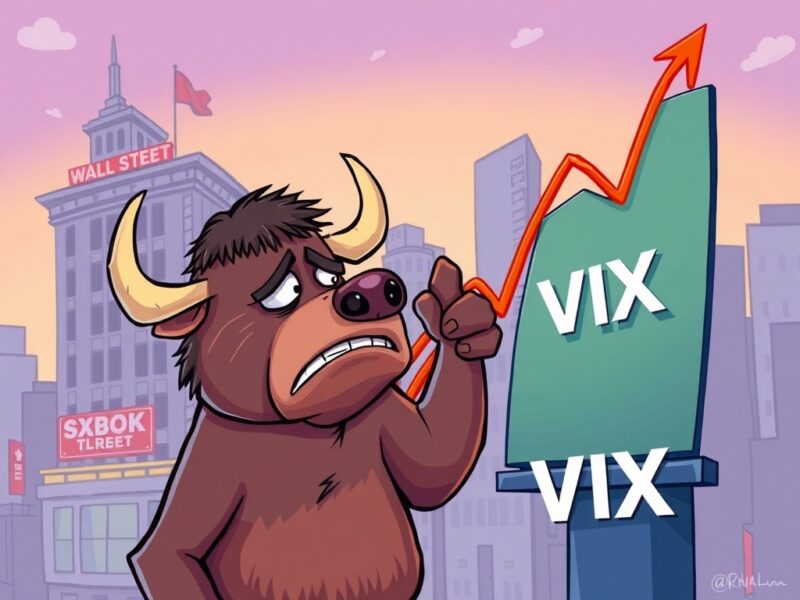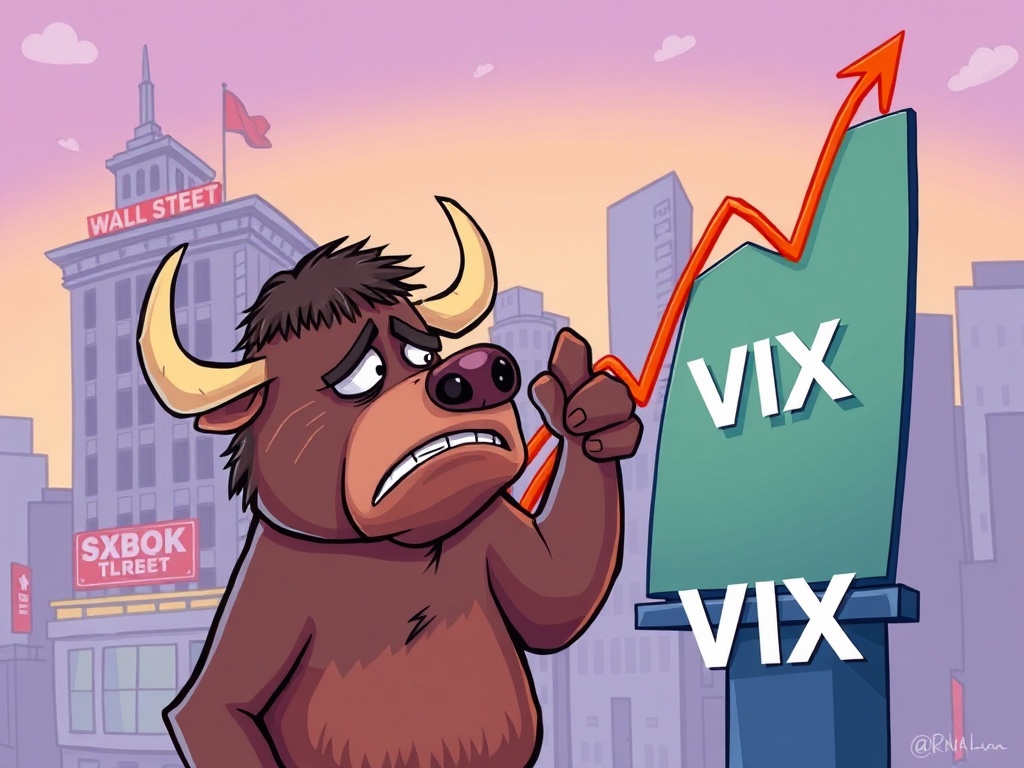Shocking VIX Surge: What Wall Street’s Fear Index Means for Crypto
0
0

BitcoinWorld

Shocking VIX Surge: What Wall Street’s Fear Index Means for Crypto
Wall Street is buzzing, and not in a good way. The Chicago Board Options Exchange (CBOE) Volatility Index, better known as the VIX, or Wall Street’s ‘fear index,’ just experienced a dramatic VIX surge, jumping 17.50% intraday to 18.93. This significant move sends a clear signal about escalating market uncertainty. But what exactly does this mean for traditional investors and, more importantly, for the often-volatile cryptocurrency markets?
What Exactly is Wall Street’s Fear Index?
The VIX index is a real-time market index representing the market’s expectation of future volatility over the next 30 days. It is derived from the prices of S&P 500 index options. Essentially, it measures the implied volatility of the S&P 500. When investors anticipate higher volatility, they typically pay more for options, which drives the VIX higher. Therefore, a rising VIX often indicates growing investor anxiety and a potential for larger market swings.
Think of it as a barometer for market sentiment. A low VIX suggests complacency and stability, while a high VIX, like the recent VIX surge, points to heightened fear and uncertainty among traders and investors. It’s a critical tool for understanding the broader market mood.
Decoding the Recent VIX Surge: What Triggered It?
The recent 17.50% jump in the VIX to 18.93 is a notable event, signaling a rapid increase in perceived market risk. Such a sharp VIX surge typically doesn’t happen without underlying catalysts. Several factors could be at play, ranging from macroeconomic concerns to geopolitical tensions. For instance, unexpected inflation data, hawkish statements from central banks, or escalating international conflicts can quickly dampen investor confidence, leading to a scramble for hedging instruments and, consequently, a higher VIX.
This rapid increase suggests that market participants are bracing for potential turbulence. It indicates a collective expectation that stock prices might become more erratic in the near term. Investors are actively seeking protection against downside risks, which is reflected in the increased demand for options and the subsequent climb in the VIX index.
How Does the VIX Surge Impact Cryptocurrency Markets?
While the VIX directly measures volatility in traditional equity markets, its movements often have ripple effects across other asset classes, including cryptocurrencies. Historically, during periods of extreme market fear, such as a significant VIX surge, investors tend to de-risk. This means they often sell off more speculative or volatile assets, including digital currencies, to move into safer havens like cash or government bonds.
Key connections to consider:
- Risk-Off Sentiment: A rising VIX often coincides with a broader risk-off environment, where investors are less willing to take on risk. This can pressure Bitcoin and altcoins.
- Correlation with Equities: Cryptocurrencies, especially Bitcoin, have shown increasing correlation with tech stocks and the broader S&P 500. When traditional markets face a downturn signaled by the VIX, crypto can follow suit.
- Liquidity Crunch: In times of panic, liquidity can dry up across all markets. This makes crypto assets, which are already prone to large price swings, even more vulnerable.
Therefore, while not a direct measure, a significant VIX surge acts as a strong indicator of potential headwinds for the crypto market.
Navigating Market Volatility: Actionable Insights for Investors
When the VIX is flashing red, it’s natural for investors to feel uneasy. However, panic selling is rarely the best strategy. Instead, consider these actionable insights to navigate periods of increased market volatility and a pronounced VIX surge:
- Diversify Your Portfolio: Ensure your investments are spread across different asset classes. While crypto is part of a modern portfolio, don’t put all your eggs in one basket.
- Dollar-Cost Averaging (DCA): Instead of trying to time the market, consistently invest a fixed amount over time. This strategy helps mitigate risk during volatile periods.
- Reassess Risk Tolerance: Use these periods to reflect on your personal risk appetite. Are you comfortable with the potential swings, or do you need to adjust your holdings?
- Stay Informed: Understand the underlying reasons for market movements. Knowledge empowers better decision-making.
By adopting a disciplined approach, you can better withstand the turbulence that a rising VIX often signals.
Conclusion: What the VIX Surge Means for Your Investments
The recent 17.50% VIX surge is a stark reminder that market volatility is an inherent part of investing. As Wall Street’s fear index climbs, it signals heightened uncertainty and potential turbulence across traditional markets, with significant implications for the interconnected world of cryptocurrencies. Understanding the VIX is crucial for interpreting broader market sentiment and making informed decisions. While fear can be contagious, a strategic and well-researched approach allows investors to navigate these choppy waters more effectively, potentially turning perceived risks into future opportunities.
Frequently Asked Questions (FAQs)
1. What is the VIX index?
The VIX (Volatility Index) is a real-time market index that represents the market’s expectation of future volatility over the next 30 days. It is derived from the prices of S&P 500 index options.
2. Why is it called the “fear index”?
It’s called the “fear index” because its value typically rises when investors are fearful and expect significant market swings. A higher VIX indicates greater investor anxiety and a higher perception of risk.
3. How does a VIX surge affect the stock market?
A VIX surge generally indicates that stock market participants anticipate increased volatility and potential declines in stock prices. It often precedes or accompanies periods of market downturns or significant corrections.
4. Is there a direct link between the VIX surge and cryptocurrency prices?
While not a direct measure for crypto, a VIX surge often correlates with a broader “risk-off” sentiment in global markets. This can lead investors to sell more speculative assets like cryptocurrencies, causing their prices to decline alongside traditional equities.
5. What should investors do during periods of high VIX?
During a high VIX period, investors should consider diversifying their portfolios, practicing dollar-cost averaging, reassessing their risk tolerance, and staying informed. Avoiding panic selling and maintaining a long-term perspective are generally recommended.
Did you find this analysis helpful? Share this article with your network to help others understand the implications of the VIX surge on their investments!
To learn more about the latest crypto market trends, explore our article on key developments shaping Bitcoin price action.
This post Shocking VIX Surge: What Wall Street’s Fear Index Means for Crypto first appeared on BitcoinWorld and is written by Editorial Team
0
0
 Manage all your crypto, NFT and DeFi from one place
Manage all your crypto, NFT and DeFi from one placeSecurely connect the portfolio you’re using to start.




